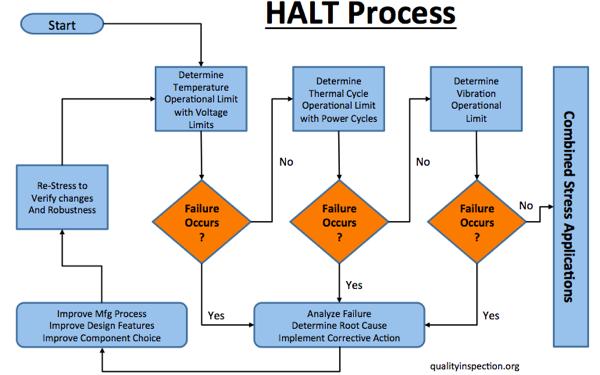 HALT and HASS are accelerated product reliability testing methods focused on finding potential defects in products. These acronyms stand for:
HALT and HASS are accelerated product reliability testing methods focused on finding potential defects in products. These acronyms stand for:
- HALT – Highly Accelerated Life Test
- HASS – Highly Accelerated Stress Screen
If you are developing a new product ready for manufacturing and you want to know if it will keep working as planned after a few years of use, you can send a few samples to a testing laboratory and ask them to perform HALT and/or HASS.
These types of tests are generally performed at different stages:
- HALT is applied to the initial product testing stages prior to production and its primary objective is to highlight failure modes and weaknesses in the design so that the design can be modified and improved to eliminate any weaknesses found.
- HASS, on the other hand, is implemented at the production stage where production samples are subjected to stress testing beyond the product specification limits but not up to the extreme levels used in HALT. The objective of HASS is to ensure products from production meet the life expectancy without showing any signs of failure modes.
The process of HALT and HASS can be applied to any product, but in practical terms, it is unlikely to be used on a simple mechanical device that has very little variability associated with its functionality.
Some of the more common product categories subjected to HALT & HASS would be:
- Consumer Electronics
- Printed Circuit Board Assemblies
- Industrial products subjected to extreme environments
- Aviation
- Military and NASA
- Marine (including submarine) products
How does HALT work?
In HALT, which is applied at the product development stages or pre-production, temperature and vibration stress conditions are used during product development to find weak spots in the product design and its planned fabrication processes.
Many other test stimuli may be applied (humidity, thermal cycling, over-voltage…). This requires only a few units. The testing generally takes a short time. The objective is to identify every weak point and to fix it. Once a new prototype has been built based on a new design, a new round of HALT should take place.
Here is the logic followed:

HALT is a good complement to a design FMEA analysis.
How does HASS work?
Let’s say the design of your new product looks robust based on HALT. The manufacturer launches production, and a whole new set of issues might appear. Production samples often differ markedly from pre-production prototypes (because processes are different), and there are often differences AMONG production samples (because of variability).
Identifying potential production failure modes as early as possible is paramount to the success of a product launch, and this is where HASS comes into play.
Some production samples are selected and placed under stress tests. These tests can detect production faults — some of which may be obvious, and some of which may not be not detectable in normal production testing.
This type of screening is particularly good at highlighting the type of failures that commonly appear in the early life of the product. (Failures that appear later in the life of a product are much more dependent on the environment and they way the product was used.)
A HASS provides the engineering team with a list of issues. They should implement corrective actions that will improve the manufacturing process and make the product more robust and reliable.
HASS is a good complement to a process FMEA analysis.
—
Any reader has experience with HALT and HASS to share?
